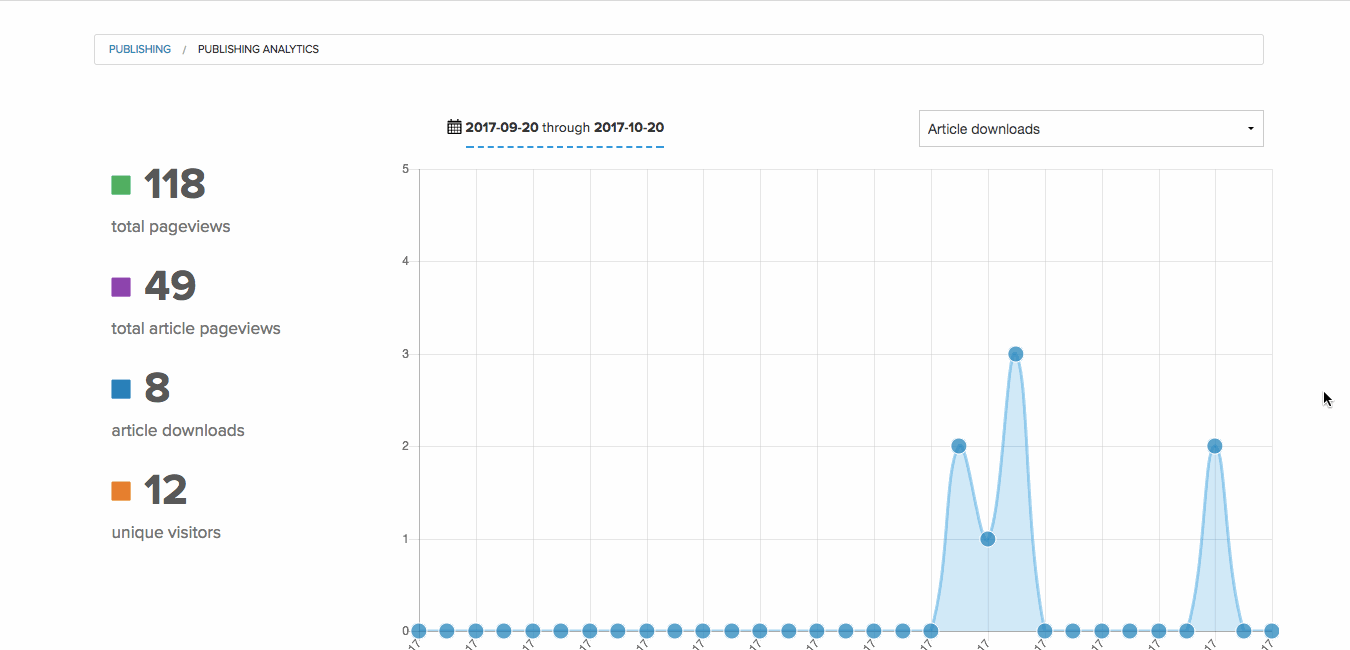
In Open Access (OA) journal publishing, the coin of the realm is readership. To have staying power and, often, to secure funding, OA journals need to demonstrate that they are growing their reader base over time and reaching as broad an audience as possible, which, in turn, will help expand their research impact.
Journals need answers to questions like, “which are our most viewed articles?” and “where are our readers coming from?” and that all depends on one thing — data.
At Scholastica, we’re developing our OA Journal Hosting Platform to make tracking core publishing stats easier than ever with a built-in analytics suite to help journal publishers and editors get in-depth readership insights, which we’re regularly enhancing. Publishers and editors of journals hosted via Scholastica can easily view their publishing analytics by following the steps in this help document. From the analytics page, they can quickly see readership metrics for the journals they work with for a particular day or given timeframe using a calendar date picker tool. All journal websites hosted via Scholastica now also include public-facing metrics pages for articles (new feature alert!) to provide authors and readers insights into article usage and impacts, including the option to integrate Altmetric Badges.
This blog post walks through everything you need to know about Scholastica’s OA publishing analytics suite and new public-facing metrics pages, highlighting all of the latest features. Let’s get to it, starting with an overview of our in-app analytics suite for publishers and editors!
Quick note: If you’re new to tracking publishing analytics and wondering what any of the different terms below mean, we have a complete glossary here to help!
Scholastica OA publishing analytics suite walkthrough
Track pageview and download stats

To get a pulse on the readership of any journal, tracking pageviews (i.e., the number of times that a page has been visited or viewed), including total pageviews for the journal and pageviews by article, is a must, along with article download counts. Tracking total journal pageviews helps teams get a sense of how the overall volume of their readership is trending over time. And editors can use individual article pageview and download insights to help guide publication planning, from generating ideas for topics for future special issues to determining which content may perform best on social media based on what’s most viewed.
In addition to using pageview and download stats to help guide editorial planning, journal teams can also share article analytics with authors to provide them added value. For example, your journal could send authors updates when their articles hit a certain threshold of pageview or download counts to help them demonstrate the impact of their work.
Scholastica makes tracking all of the above stats easy, and we even provide pageview analytics for journal blogs hosted on our platform. From Scholastica’s OA Publishing analytics suite, you can see:
- Total journal pageviews
- Top viewed articles and the number of pageviews for each article
- Top viewed blog posts with pageview counts
- Top downloaded articles, with download counts for each article
Follow growth in new visitors to your journal

Tracking pageview stats will help you determine the volume of views your journal and individual articles are getting. But there’s a good chance that many of those views will be from repeat visitors, so increasing pageviews alone may not necessarily point to readership growth. For example, editors at your journal likely view your final published articles multiple times, as do the scholars referencing them.
So how can you accurately track journal visitors and tell if the number of people coming to your website and latest articles are increasing over time?
That’s where “unique visitor” stats come into play. A “unique visitor” is anyone coming to your website for the first time during a browsing session.
We’ve included “unique visitors” in Scholastica’s OA Publishing analytics suite to help journals keep their readership stats straight, including total unique visitors and unique visitors by article. “Unique visitors” are only counted once. So, for example, one of your articles could have 1,000 pageviews but only 800 “unique visitors” due to a portion of those pageviews coming from return readers. You can use “unique visitor” stats as a point of truth to home in on how many new readers your journal and specific articles are attracting over time.
Get insights into where your readers are coming from in the world and online

Key to growing the readership of any journal is getting to know where its readers are coming from in the world and where they’re finding articles online (e.g., browsers, referring websites). We’ve included sections in Scholastica’s OA Publishing analytics suite to help you do just that.
1. Readers by country: Journals can click “Countries” on the analytics page to see where their readers are coming from geographically, which can help them determine parts of the world where they have the most traction and where they may need to work to expand their reach.
2. Referrers (sites that link to the journal): Journals can dig even deeper into where readers are coming from using the “Referrers” tab in Scholastica’s OA Publishing Platform analytics suite. Referrers are websites that include links to journal pages. For example, if your university library writes a blog post linking to one of your journal articles and a reader clicks that link, the university library blog that led the reader to your article would be considered a referrer. Your journal can use referrer insights to see who is talking about and linking to your content online, which can help you demonstrate research impact. Tracking referrers can also help you gauge the success of your marketing efforts. For example, if you put out a press release for a particularly timely article, you can check referrers to see if it’s leading people to your website.
Dig into which social media platforms are driving scholars to your journal (NEW!)

Wondering which social media channels are driving scholars to your journal website and which of your articles are getting the most attention on social? We’ve made it possible for journals using Scholastica’s OA publishing platform to find out!
Now, in addition to displaying top-viewed articles and referring websites, our built-in publishing analytics suite also includes top article visits from Twitter, Facebook, and LinkedIn, as well as referral reports (i.e., instances of readers coming from any of those social media channels). We even include links to specific referrer tweets where possible. So journals can see exactly which posts are drawing readers to their website.
Journals can use these stats to determine which social media platforms are helping to grow their readership and, consequently, which are likely to be their best promotion outlets.
New public-facing metrics for authors and readers (with Altmetric Integration option!)
Content usage stats for authors and readers

Scholastica journal websites also include public-facing metrics to help authors and readers see how content is being found and used. We list pageview and download stats at the top right of all articles hosted via our platform, and, as of October 2022, all articles now also include links to more in-depth public-facing metrics pages. Website visitors can access the metrics pages by clicking the “view more stats” link at the top right-hand corner of articles published via Scholastica.
From the public-facing metrics pages, authors and readers can see article pageview and download stats in the past seven days, 30 days, and all time, and a breakdown of the top 10 countries readers came from. Journals with a paid Altmetric account also have the option to integrate it with Scholastica’s OA Publishing Platform by following the steps in this help document to have Altmetric Badges displayed on public-facing metrics pages for all articles that have a DOI.
Automatic Altmetric Badge display

When journals integrate a paid Altmetric account with Scholastica, we automatically add Altmetric Badges to the public-facing metrics pages of articles with DOIs. Each Altmetric Badge includes an Altmetric Attention Score and links to an Altmetric details page that features a breakdown of online attention received by the article. This includes mentions and shares on Twitter, citations (through Dimensions and Mendeley), news outlet coverage, mentions in public policy documents and other channels listed here, with links to the original sources.
Altmetric Badges help journals, authors, and readers track alternative impact indicators for articles. Altmetrics can be used to monitor and report on diverse research impacts beyond traditional bibliometric citations in various ways, including:
- For authors to demonstrate broader research impacts for grant and tenure proceedings
- For authors to keep track of who is taking an interest in their research to uncover future collaboration opportunities and new research communities to engage with
- For publishers to showcase the value of their journals to stakeholders, such as funders
- For publishers, journals, and authors to identify top promotion channels for articles (e.g., social media outlets where articles are shared the most)
- For publishers, journals, and authors to track the progress of promotional activities (e.g., if author interviews with relevant industry outlets are resulting in new readers)
It is important to note that Altmetric Attention Scores are in no way meant to indicate research quality. As with bibliometric indicators, the case of attention can sometimes be article endorsements or references to errors. So it’s essential to review altmetric data in context.
Putting it all together: use analytics to help guide publication planning
Using Scholastica’s OA publishing analytics suite, journals can get a window into which of their articles are attracting the most readers, where those readers are coming from, and how their audience is growing over time. Journals can leverage publishing analytics to help guide future editorial and promotion planning to keep expanding their reach. Journal teams can also use analytics to compile annual readership reports to track their performance and demonstrate impact to key stakeholders (e.g., funding organizations). And, with the new public-facing metrics pages and Altmetric integration option, journals can provide more value to authors and readers giving them access to article usage and engagement insights.
If you have any questions, don’t hesitate to contact us — we’re here to help! If you want to see Scholastica’s OA publishing analytics suite firsthand, you can also request a personal demo of our OA journal hosting platform.
Update note: This blog post was originally published on the 6th of March 2022 and updated to reflect new features on the 16th of November 2022








